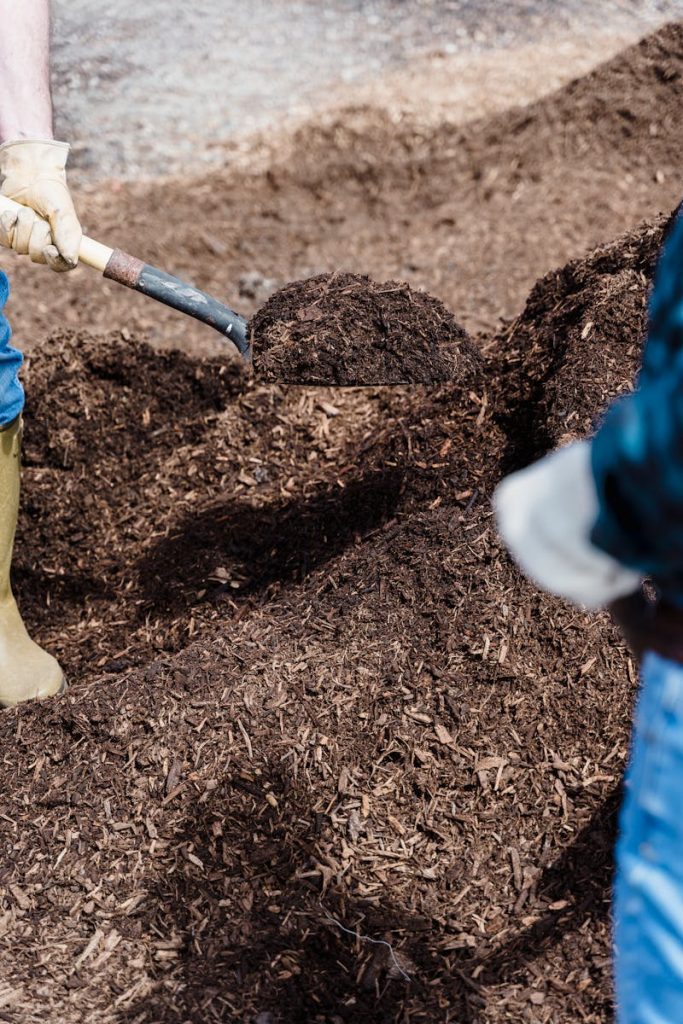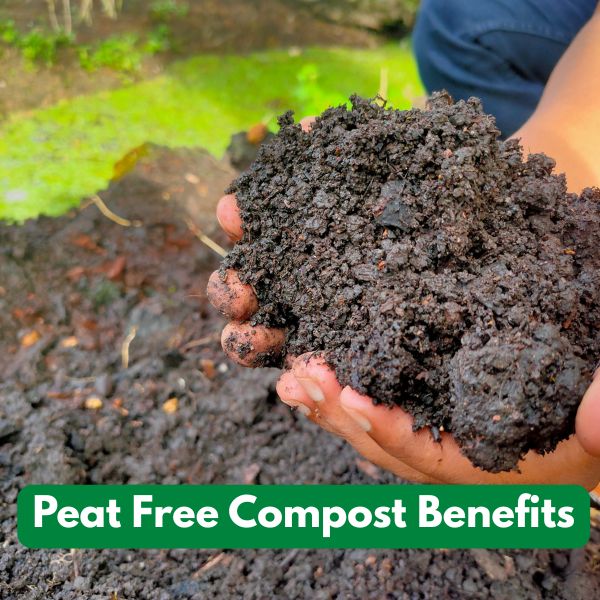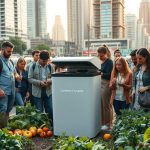Greener Gardens Made Simple and Fun
Imagine turning kitchen scraps and garden clippings into rich, dark soil that helps your plants grow.
That’s what composting is all about—recycling food waste, leaves, and even cardboard into something useful for your garden instead of tossing it in the bin.
Compost is simply decomposed organic matter that boosts healthy soil, and the act of making it is what we call composting.
Peat free compost benefits are huge if you care about the environment or simply want a greener garden.
Choosing peat free means you’re not using up precious bogs, but you’re still giving your plants everything they need.
Whether you try vermicomposting with worms or use a compost tumbler to speed things up, every small change makes a difference.
People compost to cut waste, save money, and help the planet. It’s easy to start, too.
Making compost at home is a hands-on way to live more sustainably and keep garden fun simple.
Curious about other ways to recycle at home? Check out extra tips in this sustainable waste management guide.
If you’re looking for step-by-step help, don’t miss these how-to tips for getting started with composting at home.
What Makes Peat Free Compost Different?
Peat free compost benefits go far beyond filling your flowerpots or veggie beds.
When you reach for a bag that’s not made from peat, you help protect precious peat bogs—a habitat as unique as rainforests.
Peat free composts offer that earthy boost your plants crave, but they’re made using renewable and recycled ingredients instead of ancient peat layers.
Let’s explore why that choice matters for gardens and the world.
Environmental Impact of Peat Extraction
Peat bogs are like the piggy banks of the natural world. Over thousands of years, these bogs stash away carbon in thick layers of slowly decaying plant matter.
When companies harvest this peat for garden compost, it’s like smashing the piggy bank open—vast amounts of stored carbon escape, fueling climate change.
Imagine pulling up your living room carpet and finding a whole hidden world underneath. Peatlands provide a cozy home for rare birds, insects, and plants that can’t survive elsewhere. When peat is dug up, this habitat vanishes.
According to a resource on peatlands and climate change, damaged peatlands contribute about 5% of total global carbon emissions, making peat harvesting a big problem for climate health.
In the UK alone, using peat for gardening can release up to 880,000 tonnes of CO2 in a single year (devastating climate impact of using peat in UK horticulture).
Choosing peat free compost helps keep carbon locked safely in the ground and protects those secret wild landscapes.
Switching to peat free compost is a win for biodiversity, too. Native plants, songbirds, and insects all thrive when peatlands stay undisturbed.
By going peat free, gardeners support fragile ecosystems that are disappearing fast.
How Peat Free Compost Supports Sustainable Gardening
 Photo by Ambam Gorilla
Photo by Ambam Gorilla
Peat free compost benefits sustainable gardening from the ground up.
Instead of using up something ancient and irreplaceable, peat free mixes rely on renewable, often local, materials like:
- Coconut coir (made from coconut husk, great for holding moisture)
- Composted bark and wood fibre (waste from the lumber industry)
- Green compost (recycled from garden or food waste)
These ingredients aren’t just earth-friendly—they’re surprisingly effective!
In fact, many gardeners find that peat free mixes work well with compost tumblers and even support vermicomposting with worms.
Home composting is the heart of sustainable gardening. Instead of binning veggie peelings or mowing clippings, you can transform them into nutrient-rich compost for your garden beds.
Peat free compost helps by closing the loop—turning yesterday’s waste into tomorrow’s soil, and keeping the garden growing strong.
If you’re looking for more options, the peat-free compost choices from RHS explains how modern mixes blend various plant materials to support plant roots and soil health without peat at all.
Peat free compost also reduces pressure on landfill and helps you cut waste at home. Got kitchen scraps or cardboard to recycle?
Composting them supports your plants and the planet! Want to experiment with even more eco-friendly ideas? Our composting calendar seasonal tricks can guide you on what to add and when for the best results.
By making the switch, you become part of a movement for cleaner air, healthier soils, and greener gardens—without sacrificing plant health or garden fun. Peat free compost is truly greener in every way.
Practical Peat Free Compost Benefits for Gardeners
If you want your plants to look happy, soil health is where the magic starts.
Here’s why peat free compost benefits aren’t just good for the planet—they make gardening better, smoother, and a whole lot more fun.
Whether you have a big yard or a few pots, using peat free compost can help you grow greener, lusher plants while keeping things simple.
Boosting Soil Life and Plant Vigor
 Photo by Anna Tarazevich
Photo by Anna Tarazevich
Healthy soil isn’t just dirt—it’s an underground city, bustling with insects, fungi, and bacteria that help your plants soak up nutrients and water.
Peat free compost brings this city to life! Made from things like coconut coir, plant fibers, and composted bark, it feeds the good bugs and fungi that boost plant strength and bounce.
Ever notice how plants seem happier in a home garden where compost is added?
That’s because peat free compost improves something called “soil structure”—basically, it turns compacted soil into a fluffy cake that roots love.
Think of it like giving your plants a comfy mattress instead of a rock-hard floor.
Here’s how peat free compost benefits play out:
- More Earthworms: Worms tunnel through compost-rich soil, helping air and water reach the roots. That means fewer soggy spots and healthier growth.
- Moisture Superpowers: Ingredients like coconut coir hold water and nutrients longer, so your plants have steady access all week (even when you forget to water).
- Disease Defense: A lively underground crew in your compost helps fight off root diseases, so you skip the hassle of sad, wilting plants.
Don’t let words like “microbes” and “mycorrhizal fungi” scare you! Just think of them as tiny garden helpers, chomping away at kitchen scraps and turning them into plant food.
Whether you toss compost on a veggie patch or sprinkle it in pots, you’re inviting these helpers to move in.
Did you know simple composting tricks can transform your soil into a superfood buffet?
Find even more soil health ideas to delight your roots and keep your garden thriving.
Simple Tips for Getting Started with Peat Free Composting
Starting with peat free compost might sound big, but it’s truly just a few easy steps.
Every garden is a little different, so don’t be afraid to experiment—nature is forgiving, and composting is mostly about giving things time to break down.
Let’s make it simple:
- Pick a compost spot: Any bin or pile works. For speed, try a compost tumbler. It keeps things neat and speeds up mixing (just spin and wait).
- Feed your compost bin: Layer kitchen scraps (no meat or dairy), grass cuttings, dry leaves, and small bits of cardboard. If you want an upgrade, add a handful of worms and try vermicomposting—these guys love munching on food scraps!
- Balance it out: Healthy compost needs a mix—think “greens” like food waste and “browns” like leaves or shredded cardboard. Too much of one? Things get smelly or soggy.
- Keep it moving: Turn your pile with a fork, or just give the compost tumbler a roll every week. This helps air get in, which keeps good microbes working fast.
Here’s what to avoid so you can keep things easy:
- Too much water: Sloppy compost attracts flies and smells bad. Compost should feel like a wrung-out sponge.
- Neglecting to turn: Air is key. Without mixing, your pile could go soggy or dry out.
- Throwing in plastics or pet waste: Stick to plant-based waste and plain paper or cardboard.
Ready to take composting to the next level? Get more composting tips and tricks so your peat free experiments grow into healthy soil year-round.
With peat free compost, you’ll quickly see why so many gardeners rave about the difference in their soil and plants.
It’s like giving your garden a secret ingredient that keeps everything growing strong, naturally.
Composting Year-Round: Keeping It Fun and Simple
Peat free compost benefits don’t end when the weather changes. It’s possible—and surprisingly easy—to compost throughout the seasons.
Whether you’re a fan of classic piles, a compost tumbler lover, or keen to give vermicomposting a try, a few cheerful tweaks can keep your compost thriving in sun, rain, or snow.
Let’s look at how to make composting easy all year and sort out common bumps along the way.
Seasonal Success: Adapting Composting to Your Climate
 Photo by Sippakorn Yamkasikorn
Photo by Sippakorn Yamkasikorn
Weather can play tricks on your compost, but you can work with it—not against it.
Here’s how to keep your peat free compost on track, season by season.
Spring:
- Piles wake up from winter. Mix last year’s bins, add a boost of green waste, and watch the magic restart.
- Try covering your compost with an old tarp to lock in extra warmth and speed things up.
Summer:
- Heat means fast compost, but it can dry out. Check moisture: compost should feel like a wrung-out sponge.
- If it looks parched, water gently or add extra kitchen scraps. Putting your bin in light shade can prevent overheating.
Autumn:
- Leaves galore! Use them as “browns” to balance summer’s “greens.” Shred tough leaves with your mower for quicker breakdown.
- If you have a compost tumbler, turn it more often to speed things along as the weather cools.
Winter:
- Don’t panic if things go slow—microbes hibernate in the cold. Keep adding scraps and browns in layers, but expect a compost nap.
- Insulate your bin with straw or cardboard. Even wrapping a compost tumbler in bubble wrap can help it stay active longer.
Handy tip: Worm bins for vermicomposting are happiest indoors when temperatures drop—think garage, shed, or even under the kitchen sink!
For more guidance on composting through every season, tap into tricks from the composting calendar for thriving bins.
If you want a full rundown of weather-friendly composting, this composting in different climates guide explains even more ways to insulate, shade, and protect your setup year-round.
Troubleshooting: Easy Fixes for Common Composting Issues
Even expert composters have a bin that gets a bit whiffy or soggy now and then.
It’s normal! Peat free compost setups are straightforward, and most problems have friendly fixes.
Here are a few everyday problems and what you can do:
1. Odours:
- If your compost smells bad, it’s likely too wet or has too many food scraps.
- Fix: Mix in dry browns like shredded paper, cardboard, or autumn leaves. Turn or roll your pile every time you add new scraps.
2. Too Wet or Too Dry:
- Soggy compost isn’t happy. If it’s dripping or slimy, there’s not enough air.
- Fix: Stir in plenty of dry brown material. Don’t be shy! Repeat as needed.
- If your bin seems dusty or shrinks down fast, it’s too dry.
- Fix: Sprinkle water as you turn the pile, or add more green scraps. Check moisture a couple times a week, especially in summer.
3. Pests:
- Unwanted visitors (like flies or rodents) love a free buffet.
- Fix: Only add fruit and veggie scraps—never meat, dairy, or oily food. Cover fresh additions with a layer of browns every time.
4. Slow Breakdown:
- Compost not moving? Could be the cold or too much of one type of ingredient.
- Fix: Chop or shred big pieces, alternate greens and browns, and add a good turn every week. A compost tumbler helps keep materials mixed and speeds up the process.
5. Worm Bin Woes (for vermicomposting):
- Worms escaping? They might be too hot or wet, or their bedding could be depleted.
- Fix: Check the bedding, add more shredded cardboard, and move the bin to a calmer spot if it’s in direct sun.
If a stubborn problem pops up, there’s always help available—just check the composting FAQ at Compost Charm for instant advice, or read this handy how to fix common compost problems list to get things back on track.
Remember, everyone has a smelly pile now and then.
The peat free compost benefits are well worth a bump or two. With a few tweaks and some good advice, you’ll turn any fussy bin into garden gold.
Summary: Why Peat Free Compost Is the Future of Greener Gardens
If you’re aiming for a garden that thrives while still caring for the earth, the movement toward peat free compost is only getting louder.
Over the past decade, gardeners have seen peat free composts become the go-to solution for anyone who wants lush plants without harming fragile bogs or sending carbon into the sky. Short on time or just wanting an easy win?
Peat free options fit the bill for beginners and pros alike.
Let’s break down why peat free composting stands at the heart of tomorrow’s gardens and why it’s quickly becoming the soil of choice for greener living.
Preserving Nature for Future Generations
 Photo by Greta Hoffman
Photo by Greta Hoffman
One of the clearest peat free compost benefits is protection—of peatlands and everything living in them.
Picture peat bogs as nature’s sponges that soak up water, stash away carbon for centuries, and give a home to rare critters.
When peat is dug up for gardening, carbon escapes into the air, and habitats vanish in an instant. By choosing peat free compost, you’re keeping these wild spaces intact for wildlife and generations of gardeners down the road.
Sustainable Ingredients with Big Impact
Unlike traditional compost mixes made with peat, peat free composts use renewable materials like coconut coir, bark, green compost, or wood fibre.
These ingredients are not only easy to replace, but often come from recycled waste streams—think sawmill leftovers or your own kitchen scraps.
Adding them to your soil does more than just help the planet:
- They hold onto water longer, so your compost bin stays moist and healthy.
- They break down with the help of composting worms during vermicomposting, giving your plants an extra nutrient kick.
- Green composts boost the soil structure for roots, making it perfect for both garden beds and when using a compost tumbler.
You can learn about more ways peat free compost supports gardens and the earth from insightful guides such as Why Go Peat Free and see how gardeners are making sustainable swaps without losing out on results.
Healthier, Happier Gardens—For Everyone
Peat free compost isn’t just better for nature. Home gardeners find that modern peat free mixes actually help keep plants healthy and soil bustling with life.
Earthworms multiply, roots stretch deeper, and you’re far less likely to face flooded flowerpots or tired tomatoes.
Why does this matter for new composters?
Because you get all the fun of creating rich, crumbly compost—whether that’s through classic composting, vermicomposting, or by spinning up a fresh batch in your compost tumbler—while knowing you’re doing something good for the planet and your plants in one easy step.
If you’ve never made the switch before, start small. Even just mixing a bit of peat free material into your usual batch or using it as a top dressing can make a real difference.
Want to get hands-on? Discover other easy composting solutions you can try at home, or check out a season-by-season composting calendar to keep your compost pile happy all year.
Leading the Way to a Greener Tomorrow
Switching to peat free composting is more than a gardening trend—it’s a step toward a smarter, kinder way of living.
The choices you make in your own garden matter. Every handful of peat free compost you use keeps carbon where it belongs and gives local wildlife a better shot at survival.
Experts and eco-conscious gardeners agree: peat free is both the practical and ethical way forward.
Learn more about the deeper reasons behind this shift from Is Peat-Free Compost Better? to get the full scoop on how your everyday actions can lead to cleaner air, richer soil, and healthier communities.
By weaving together new habits, the right tools, and a little patience, anyone can help grow the gardens of the future.
Peat free compost benefits make that future brighter, greener, and much more fun—for all of us.

Your Peat Free Composting Questions Answered (FAQ)
Choosing peat free compost is a simple change with big rewards. Many gardeners have questions before they switch.
Below you’ll find clear, straight answers to the most common worries about peat free compost benefits, composting methods, and practical compost tools.
If you’re starting out or just seeking better results from your compost tumbler or vermicomposting efforts, this FAQ is for you.
What Exactly Is Peat Free Compost?
Peat free compost is a blend for gardening that doesn’t include any peat taken from bogs. Instead, it uses renewable materials like composted bark, coconut coir, wood fibre, and green waste.
These ingredients do the job of peat without damaging rare habitats or sending extra carbon into the air.
Key benefits include:
- Protects peatlands and wildlife
- Uses recycled, earth-friendly materials
- Supports healthy plant growth
Peat free compost often feels and works differently than peat-based options, but modern blends hold water, feed microbes, and give roots room—everything your plants could want.
Does Peat Free Compost Work as Well as Traditional Peat-Based Compost?
Yes, but sometimes it takes minor adjustments. Most gardeners see strong growth and happy, healthy plants.
Some peat free composts drain a bit faster or dry out sooner, so keep an eye on watering, especially with pots.
A few helpful tips:
- Water slightly more often with peat free mixes.
- Mix in your own home compost for extra nutrients.
- Blend with organic matter like leaf mould for moisture balance.
If you’re working with large piles of leaves or want to explore the science behind how compost breaks down, check out these composting leaves techniques for added detail.
Can I Use Peat Free Compost in My Compost Tumbler or Worm Bin?
Definitely. Peat free compost is great for top-ups in both compost tumblers and vermicomposting systems. If you make your own compost, add peat free mulch or use it as a “brown” layer.
Compost tumblers love the extra structure that coconut coir and wood fibres add, helping the contents break down evenly and without compaction.
For vermicomposting, peat free blends are gentle on worms. They create good bedding and don’t upset the balance.
Remember, worms need moisture but not a soggy mess—aim for that “wrung out sponge” feel.
Are There Plants That Don’t Like Peat Free Compost?
Almost every garden plant thrives in good peat free compost. Some picky seedlings or acid-loving plants (like blueberries or azaleas) might need special ericaceous, peat free compost with lower pH.
Always check plant labels, but for most vegetables, flowers, or houseplants, peat free options provide great results.
- For acid lovers: look for special mixes labeled “peat free ericaceous compost.”
- For seeds: try blending peat free compost with a bit of sand or perlite for a light seed-starting mix.
How Can I Make My Peat Free Compost Work Better?
Getting the most from peat free compost is easy with a few habits:
- Keep an even mix of “greens” (food scraps, grass) and “browns” (dry leaves, cardboard).
- Use a garden fork or compost tumbler to turn your bin each week.
- Add shredded cardboard to raise structure and hold moisture.
- Water as needed—peat free compost sometimes needs just a bit more to stay springy.
If you want even more practical ways to improve your compost, don’t miss our top composting calendar tips for seasonal advice and tricks.
What Should I Avoid When Using or Making Peat Free Compost?
A few things make any compost—peat free or not—struggle. Here’s what to keep out of your bin:
- Meat, dairy, and oily foods (attract pests and slow down the process)
- Glossy paper or synthetic materials
- Weeds with seeds or invasive roots
- Large chunks of wood unless they’re chopped small
Peat free compost thrives on balance—stick to plant-based kitchen scraps, garden waste, and plain paper or cardboard.
Where Can I Get Help If My Compost Isn’t Breaking Down?
Troubleshooting is part of composting fun! If your compost tumbler isn’t heating up or your vermicomposting bin seems slow, small changes can help.
Try turning the pile more often or adjusting the greens-to-browns ratio. For leaf-heavy compost, adding a scoop of soil or finished compost sometimes does the trick.
Check out advice from our step-by-step starting composting at home guide, or ask your own question using our Ask A Question tool.
No matter where you are on your composting journey, peat free compost benefits everyone—gardeners, plants, and the planet.
Small tweaks and a sense of curiosity keep compost healthy and rewarding for all.
Is peat-free compost better?
Is peat-free compost better? The answer isn’t as simple as yes or no.
Choosing peat-free compost helps protect peat bogs, which store lots of carbon and support rare plants and animals.
When peat is taken from these bogs, it can destroy habitats and release extra carbon into the air.
Using peat-free options like coir, wood fiber, or grass clippings can make a real difference for the environment.
Many new peat-free composts are designed to hold moisture well and provide the nutrients plants need.
Some people say they work just as well as composts with peat. Still, not all peat-free mixes are perfect.
A few have issues with drainage or air flow, which might affect some types of plants.
Is peat-free compost better for everyone? That depends on your garden and what you like to grow. If you want to support nature and cut down on carbon, peat-free is a strong choice.
But some gardeners still prefer the way traditional compost works in certain situations.
Try both and see what’s right for your plants.
There’s no single answer, but with a little testing, you’ll find what fits your garden best.
Conclusion
Peat free compost benefits bring gardening back to its roots—caring for nature while growing thriving plants at home.
Small actions, like adding peat free compost to your routine or trying out a compost tumbler or vermicomposting, help protect wild habitats and boost your own soil life.
Anyone can make these eco-friendly swaps, one handful at a time.
Curiosity keeps composting fun.
Ask questions and try new methods, or tap into helpful guides such as the Don’t Toss It Campaign for ideas on recycling kitchen scraps.
Join fellow composters, share your progress, or discover more inside the Compost Charm community.
Your journey to a greener garden supports the earth and grows new possibilities—with every crumb of compost you create.





